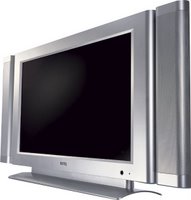BenQ DV3750 - LCD TV
 For thin and flat televisions, liquid crystal displays offer the most resolution at any given screen size. Unfortunately, when screen size tops 40 inches, LCD HDTVs increase exponentially in price. The 37-inch Westinghouse LVM-37w1 ($2,299 list) is one of the best values. Besides offering native 1080p resolution (1,920 by 1,080 pixels), it was the first LCD TV we had seen that would accept a 1080p signal from DVI or VGA inputs. Now BenQ has introduced a 37-inch 1080p LCD TV, the BenQ DV3750, for the same price, so we were interested to see how it would compare with the technically similar Westinghouse.
For thin and flat televisions, liquid crystal displays offer the most resolution at any given screen size. Unfortunately, when screen size tops 40 inches, LCD HDTVs increase exponentially in price. The 37-inch Westinghouse LVM-37w1 ($2,299 list) is one of the best values. Besides offering native 1080p resolution (1,920 by 1,080 pixels), it was the first LCD TV we had seen that would accept a 1080p signal from DVI or VGA inputs. Now BenQ has introduced a 37-inch 1080p LCD TV, the BenQ DV3750, for the same price, so we were interested to see how it would compare with the technically similar Westinghouse.Setup was relatively simple. After removing the TV from the box, we attached the side-mounted speakers, plugged the power cord into the wall, and inserted the NTSC TV tuner module (a smallish box packaged with the speakers) into an expansion bay on the rear.
The comfortably rounded remote has clearly labeled buttons with ample spacing and tactile feedback but, unfortunately, no backlight or direct A/V input selection, and the keys don't glow. The display's factory-attached base doesn't tilt or swivel.
You'll find A/V inputs for a DVI (HDCP-compatible for content-protected sources) and VGA connection as well as a pair of component video connectors. We'd prefer to have an additional digital video input, but this is an acceptable configuration for an entry-level HD monitor. In addition to the standard A/V inputs in back of the TV, there's an input block conveniently located on the left edge.
We first evaluated the DV3750's handling of over-the-air HDTV, PC-based Microsoft Windows Media HD video, and DVD videos played on our reference Denon DVD-3910. Brightness was ample for a well-lit room (as it is with most LCD TVs), but the backlight controls lacked the adjustment granularity and range of those on the LVM-37w1. (On an LCD TV, an adjustable backlight is the ideal way to optimize light output for eye comfort without sacrificing light or dark picture detail.)
We also noticed significant visual differences between images from the component and DVI video inputs. Component video lost dark detail, though DVI was normal. When we tried to correct the component-video quality by adjusting the brightness and contrast, changing one setting even slightly would affect the other, causing a loss of bright or dark detail. In the end, the factory default settings provided the best compromise. Finally, we were disappointed that tint adjustments were disabled for component and DVI video input.
Although the TV offers native 1080p resolution, we couldn't get that when using PC sources. Even through the DVI and VGA connections, the maximum progressive resolution we could achieve was 1,360 by 768 pixels. If your source is a PC, the Westinghouse LVM-37w1 remains a better choice for full 1080p resolution support.
The HQV benchmark-test DVD is a challenging test for any video processor, but the engine in the DV3750 turned in the lowest score we've seen yet. The display did a poor job of suppressing jagged edges in interlaced video and lacks controls for reducing video noise. We suspect there was some slight noise reduction taking place, but the monitor doesn't indicate whether it's performing any. The 2:3 pulldown/engagement process used to convert video sources that are based on film (which runs at 24 frames per second) to the 30 fps of television displays was sluggish, sacrificing image detail and introducing artifacts into the resulting picture until the process properly engaged. After, the image was normal.
Our objective measurements using a Konica Minolta CA-210 color analyzer revealed excessively high color temperatures, which caused the picture to have a bluish tint. The display's lowest color-temperature preset (more red) was still above the standard used in film and video production. But contrast-ratio measurements calculated from 9 points on an ANSI checkerboard test pattern were an impressive 787:1. In addition, the DV3750 ranked as the most evenly illuminated LCD to enter our lab. Corner to corner, it bested the uniformity of products from LCD giants such as Sharp and LG on this critical measurement.
The calibration test patterns from our Sencore VP-403 signal generator revealed that the DV3750 performed best with DVI. Resolution tests using that input showed excellent definition with 720p signals but some degradation of fine detail with 1080i signals. Fine detail was lost at component-video resolution with common signal formats (480i to 1080i). Overscan (the amount the picture extends beyond the edges of the display's active area) was nonexistent at 720p and was an acceptable 1 percent with 1080i signals.
The BenQ DV3750 LCD monitor produces an exceptionally uniform picture, and image quality is good when using its DVI input. But we're troubled by the TV's handling of component-video input, which was poor, causing a loss of fine and dark details in the picture. When you add the painfully ineffective adjustment controls that make proper calibration all but impossible and the inability to accept a 1080p signal from a PC, the combination makes the DV3750 disappointing as an HD monitor.
[via: pcmag.com]





